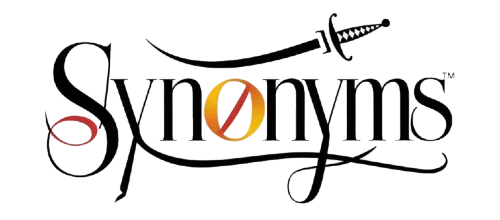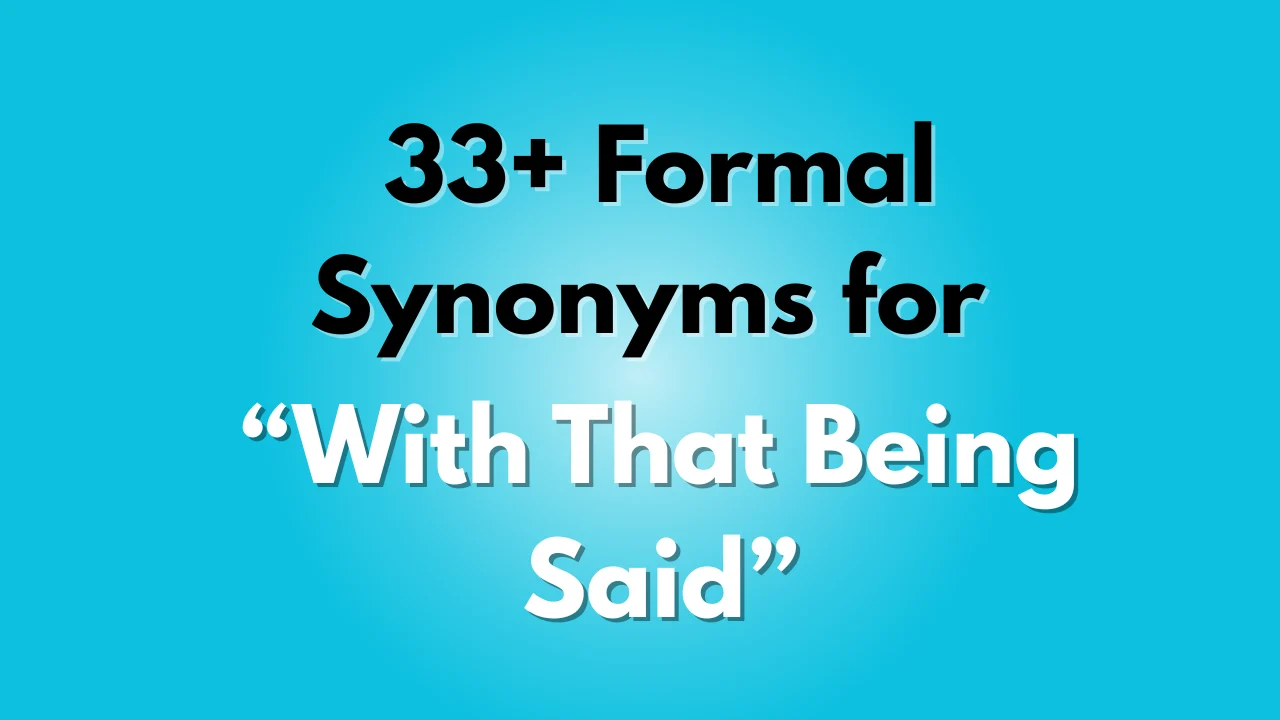The phrase “with that being said” is commonly used to transition between ideas, introduce a conclusion, or present a contrasting point. While it’s perfectly acceptable in everyday communication, it can feel repetitive—especially in professional writing, academic papers, business reports, or polished presentations. Using more formal, sophisticated alternatives not only sharpens your communication but also elevates your tone and clarity.
Whether you’re drafting an email, giving a speech, or composing a research document, having a strong collection of transitional phrases helps you structure your ideas with precision. In this guide, you’ll discover 33+ advanced and formal synonyms for “with that being said,” complete with meanings and examples to help you convey nuance confidently.
What Does “With That Being Said” Mean?
“With that being said” is a transitional phrase used to connect a previous statement with a new point—often a conclusion, clarification, or contrast. It signals that you’re building on earlier information or shifting to the next logical idea.
Its tone is neutral to semi-formal, but in highly professional or academic contexts, more polished alternatives are preferred.
When to Use It
Use this phrase when you want to wrap up a point, transition smoothly, or introduce a qualification. It’s common in:
- Professional emails
- Business presentations
- Research papers
- Academic writing
- Client communication
- Policy or report writing
Examples:
- The results are promising. With that being said, further research is required.
- We value your feedback. With that being said, certain policies cannot be modified.
Is It Polite or Professional?
Yes—it’s polite and acceptable in business contexts. However, it’s considered semi-formal, and many professionals prefer more refined alternatives that sound sharper and more authoritative.
Formal synonyms can make your writing more impactful, especially when addressing executives, academic audiences, or clients.
33+ Formal Synonyms for “With That Being Said”
Each alternative includes meaning, tone, an example, and a brief explanation.
1. Nevertheless
Meaning: Introduces a contrasting point.
Tone: Formal
Example: The data set was limited; nevertheless, the findings were significant.
Why use it: Ideal for academic or analytical writing.
2. Nonetheless
Meaning: Despite the previous point.
Tone: Formal
Example: The risk is high; nonetheless, the opportunity is substantial.
Why use it: Concise and authoritative.
3. However
Meaning: Adds a contrasting or clarifying statement.
Tone: Professional
Example: The plan is effective; however, implementation requires more time.
Why use it: A business-friendly classic.
4. Even so
Meaning: Acknowledges a point while introducing a counterpoint.
Tone: Semi-formal
Example: The team faced challenges; even so, they delivered on schedule.
Why use it: Balanced and logical.
5. Having said that
Meaning: Introduces a contrasting or wrapping point.
Tone: Formal
Example: The proposal is strong; having said that, revisions are needed.
Why use it: Smooth and professional.
6. That said
Meaning: A concise way to introduce contrast.
Tone: Professional
Example: The results are positive; that said, we must remain cautious.
Why use it: Crisp and modern.
7. Even though that is the case
Meaning: Acknowledges information before presenting a counterpoint.
Tone: Academic
Example: The evidence is compelling; even though that is the case, gaps remain.
Why use it: Excellent for research writing.
8. In light of this
Meaning: Uses previous information to justify a new point.
Tone: Very formal
Example: In light of this, we recommend adjusting the timeline.
Why use it: Great for reports and decision-making documents.
9. In any case
Meaning: Moves the discussion forward.
Tone: Semi-formal
Example: The debate continues; in any case, action is required.
Why use it: Helpful for transitioning smoothly.
10. Even with that in mind
Meaning: Recognizes the earlier point before adding more.
Tone: Formal
Example: Even with that in mind, the proposal remains viable.
Why use it: Clear and reasoned transition.
11. With this in mind
Meaning: Introduces a conclusion based on prior information.
Tone: Formal
Example: With this in mind, we proceed to the next phase.
Why use it: Logical and professional.
12. As a result
Meaning: Shows consequence.
Tone: Highly formal
Example: As a result, new protocols will be implemented.
Why use it: Perfect for cause-and-effect structure.
13. Accordingly
Meaning: Introduces action aligned with prior information.
Tone: Very formal
Example: Accordingly, we have revised the schedule.
Why use it: Excellent for business or legal documents.
14. Therefore
Meaning: Concludes or infers logically.
Tone: Formal
Example: Therefore, we recommend further analysis.
Why use it: Strong academic tone.
15. Thus
Meaning: Presents a conclusion or result.
Tone: Very formal
Example: Thus, the initial hypothesis is supported.
Why use it: Concise and authoritative.
16. As such
Meaning: Draws a logical conclusion.
Tone: Business formal
Example: As such, additional training is required.
Why use it: Great for executive communication.
17. Consequently
Meaning: Expresses a direct outcome.
Tone: Academic
Example: Consequently, the project will be postponed.
Why use it: Strong for scientific or analytical writing.
18. Moving forward
Meaning: Signals a transition to future steps.
Tone: Professional
Example: Moving forward, we’ll implement stricter guidelines.
Why use it: Ideal for business planning.
19. On that note
Meaning: Moves to a related but new point.
Tone: Semi-formal
Example: On that note, let’s review the updated strategy.
Why use it: Works well in presentations.
20. In conclusion
Meaning: Summarizes and closes.
Tone: Formal
Example: In conclusion, the data supports our strategy.
Why use it: For final remarks or wrap-ups.
21. To summarize
Meaning: Condenses earlier points.
Tone: Professional
Example: To summarize, both options are viable.
Why use it: Academic and report-friendly.
22. To that end
Meaning: Connects reasoning with purpose.
Tone: Very formal
Example: To that end, we propose a revised framework.
Why use it: Excellent for proposals.
23. In summary
Meaning: Brief wrap-up.
Tone: Academic
Example: In summary, the findings align with our expectations.
Why use it: Good for reports or conclusions.
24. In turn
Meaning: Shows sequence or cause.
Tone: Professional
Example: This increases efficiency, which in turn reduces costs.
Why use it: Polished and clear.
25. That being the case
Meaning: Accepts a statement before transitioning.
Tone: Formal
Example: That being the case, we must revise our approach.
Why use it: Precise and authoritative.
26. In other words
Meaning: Restates or clarifies.
Tone: Semi-formal
Example: In other words, the model needs adjustment.
Why use it: Useful for explanation-heavy writing.
27. With that in consideration
Meaning: Builds on earlier points.
Tone: Formal
Example: With that in consideration, we’ll modify the proposal.
Why use it: Great for decision-making statements.
28. Given these points
Meaning: Draws a logical conclusion.
Tone: Academic
Example: Given these points, the policy requires updates.
Why use it: Strong for structured arguments.
29. In view of this
Meaning: Reflects on earlier ideas to introduce the next.
Tone: Very formal
Example: In view of this, we must reconsider our strategy.
Why use it: Ideal for legal and executive tone.
30. In effect
Meaning: Shows implication.
Tone: Professional
Example: In effect, the decision streamlines operations.
Why use it: Concise and analytical.
31. By extension
Meaning: Expands the previous idea.
Tone: Academic
Example: By extension, this impacts the entire workflow.
Why use it: Excellent for logical reasoning.
32. To elaborate further
Meaning: Introduces a deeper explanation.
Tone: Formal
Example: To elaborate further, the results indicate key trends.
Why use it: Helpful for detailed analysis.
33. To put it another way
Meaning: Restates a complex idea more clearly.
Tone: Professional
Example: To put it another way, the risks outweigh the benefits.
Why use it: Improves clarity and precision.
34. Building on that
Meaning: Introduces a connected point.
Tone: Semi-formal
Example: Building on that, let’s explore alternative solutions.
Why use it: Smooth and logical transition.
35. In addition to that
Meaning: Adds supporting information.
Tone: Professional
Example: In addition to that, we’ll need further approvals.
Why use it: Effective for structured arguments.
Conclusion
Transitions shape the clarity and flow of your writing, especially in formal or professional settings. While “with that being said” is widely used, stronger and more precise alternatives can elevate your tone, improve readability, and help you communicate with more authority. Whether you’re presenting a contrasting point, drawing a conclusion, or introducing a new idea, the 33+ phrases above give you refined options suitable for emails, reports, presentations, and academic work. Choose the phrasing that best aligns with your intention, and let your writing reflect confidence, clarity, and professionalism.



